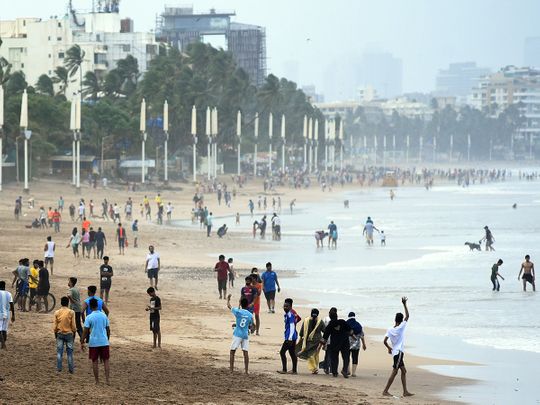
"Cyclones to drought — Know how extreme weather will hit India in the next 20 years,” reads a news headline reporting the latest report by the United Nation’s Intergovernmental Panel on Climate Change.
Such headlines do disservice to the issue of climate change because they unwittingly present climate change as a problem of the future. The truth is that we are already facing he adverse consequences of climate change. We don’t even need studies and data to acknowledge that the frequency and intensity of extreme weather events has increased in just the last 20 years or so.
We now see cyclones hitting places they didn’t earlier. A lot of sudden rainfall, even cloudbursts, have become a normal occurrence. Many big cities in India have already witnessed extreme rainfall leading to floods.
Just this monsoon season alone, there have been floods in parts of Maharashtra, Karnataka, and Madhya Pradesh and many have died. How normal is it to hear of excess rainfall in the ravines of Chambal in Madhya Pradesh?
It is hard to overstate the importance of the monsoons to India’s economy. While the monsoons have always been unpredictable and erratic, climate change threatens to make them a lot worse.
Already, a report by Christian Aid estimates that the country worst-hit by extreme weather events in 2020 was India. Over 2,000 lives were lost to floods caused not by poor water management but by cyclones and excess rainfall in a very short time. We also hear of people dying of lightning more often than we used to.
Climate change is far too urgent an issue to be left to policy wonks. It needs to be front and centre in the media. The public should demand to know from their politicians what they are doing about it.
With a coastline of over 7,500 kilometres, India is one of the most vulnerable countries to climate change. Here are 5 most urgent aspects of combating climate change where India must step up its game.
1) Build climate resilient infrastructure
Since climate change with its extreme weather events is already here, the most urgent task is to build climate resilient infrastructure. In fact, one study says that improving infrastructure (such as concrete houses) have already saved millions of lives in India despite a gradual increase in extreme weather events over the last 50 years.
In 1999, a cyclone in Odisha killed 10,000 people. Strong cyclones hit Odisha every now and then, but the number of deaths now are in single digit. Odisha has done wonders with cyclone preparedness. This includes alarm and warning systems, cyclone shelters in coastal areas, and using building materials that are not weakened by floods.
All of India will now need to think this way. Just as all infrastructure keeps potential earthquakes in mind, we have to think of rising temperatures, heatwaves, floods, and sudden bursts of rainfall. Urban planning must focus on reviving natural water bodies or, inter alia, figure out new ways to make cities drain out water faster. From power grids to public transport, all infrastructure needs to assess and mitigate risks from extreme weather events.
2) Announce net-zero emissions by 2050
Yes, the developed first world has been the major polluter. Reminding them of this again and again is important because they must pay up to help developing countries fight climate change. But India cannot just keep repeating this as a bargaining chip and wait for the first world to put their money where their mouth is.
If the world is a sinking ship, India has got to do what it can, with or without help. India needs to commit itself to net zero emissions by 2050, with an annual and 5-year targets to get there.
More than 100 countries have committed to net-zero emissions but India, the third largest emitter, is not one of them.
Net-zero emissions can be achieved not just be reducing emissions but also cleaning up the environment of the greenhouse gases already emitted. Many see net-zero targets as being unrealistic. But we need to account for a number of innovations scientists are working on to help us get there.
To be able to spend our attention and resources on such innovation, we first need to commit to a target, because time is running out.
3) Triple spending on climate change innovation
It is not going to be possible to achieve net zero targets without innovation. India sees these targets as unfair, extra economic burden since the west has already polluted its way to prosperity. Tackling climate change cannot be allowed to slow down India’s march to prosperity.
By focusing on climate change innovation, India can turn this into an economic opportunity. If the next big climate change innovation could come from India, there will be global demand to be met.
A company in Ireland is working on a new air-conditioning technology that completely avoids polluting gases. Why can’t such innovation come from India? The Indian government needs to heavily invest in climate change innovation, immediately tripling its meagre budget.
4) Go EV-only by 2030
India has done well to upgrade to less polluting automobile technologies from time to time. Can India have only electric and hybrid vehicles selling at its auto showrooms by 2030?
The Indian government expressed its intention to do so before the pandemic. But COVID has slowed down the transition. Eight years, however, is enough for transformative policy change. Where there is a will, there is a way.
Retiring the combustion engine will need some bold steps. Mere tax breaks and slowly building the EV charging infrastructure is not enough. Innovation will drive down battery costs and increase the range of electric cars in no time. We don’t have to wait.
It is a shame that the leader in Indian passenger cars, Maruti Suzuki, is taking no lead in the EV segment. It is clear that the Indian government needs disincentives to make car companies push EV cars and infrastructure into the market.
Tax incentives should be given to car companies that set up EV charging points and sell at least a small percentage of their inventory in EVs. Companies that fail to do so should face higher taxes.
5) Make major polluting industries spend on green hydrogen and carbon capture
Achieving net-zero emissions is not going to be possible without involving private industry. And private industry is rather good at evading accountability. India is poor at even recording data on their contribution to greenhouse gases.
Major polluting industries — in sectors such as chemicals, coal, transport and so on — should be required by law to invest in technologies that reduce greenhouse gases.
Two such technologies already available are green hydrogen and carbon capture. Green hydrogen is a clean fuel made from renewable energy. It is expensive, but its production does not use fossil fuels that result in emission of greenhouse gases. The good news is that the Indian government has just announced its intent to do so for petroleum refining and fertiliser companies.
Carbon capture is a new technology that captures the carbon emitted in the air and stores it. Industrial sectors that emit a lot of greenhouse gases have a responsibility to invest in this technology.
It is only if every industry, every building, every institution is carbon neutral that India can be net-zero in its emissions by 2050. Regardless of what other countries do, we will have the satisfaction of knowing we did our best to combat climate change, reducing some of its cataclysmic impact on our own citizens, and the world at large.









